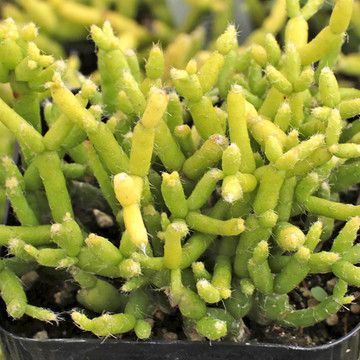Rhipsalis (rip-SALL-is) are unique varieties of cactus with slender, branching stems. The spines are tiny and gentle to the touch, so this is a safe cactus to grow in the home. They also tolerate lower light and more frequent water than most cacti. Read on for more helpful succulent care tips.
APPEARANCE
- Form: The stems are long and narrow. Many of which are angled and slightly ribbed. They branch profusely into a hanging or trailing bush.
- Colors: They're mostly lime green but many develop a cherry red color as well.
- Foliage: Most species in this genus have foliage that is organized exclusively into spines, however, a few actually have photosynthetic leaves.
- Flowers: Rhipsalis has some of the smallest flowers in the cactus family. They are usually white but some have red or green colorations as well.
CARE
- Light: They prefer partial shade conditions and can burn if given too much sunlight.
- Soil: Pick a gritty, well-draining mix like a cactus and succulent soil (available at garden centers) or mix your own (more info).
- Water: Water deeply enough for water to run out the container’s drainage holes. Allow soil to completely dry before watering again. Please note that Rhipsalis tends to need more water than many other cacti.
- Hardiness: Rhipsalis are not frost hardy and should be brought indoors to a sunny window sill if there is a chance of frost. (What’s my zone?)
- Propagation: These plants are very easy to propagate via stem cuttings.
NOTES FROM THE NURSERY
This genus is mostly made up of epiphytes, which are plants that grow on other plants without being parasitic. They do this in order to get above the herbal chaos of the jungle floor and find new pockets of light to occupy. In this way, they grow in a similar way to orchids.
It's important to not let these plants dry out as much as your other cacti because they're used to growing in jungle environments in Brazil, Peru, Costa Rica and Paraguay. Remember this when trying to take care of this cactus. These are a far cry from the stereotypical Sanguaro of the Mexican desert as far as care is concerned.
READ MORE
